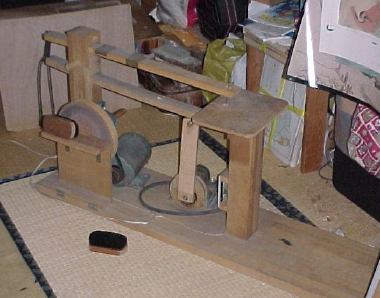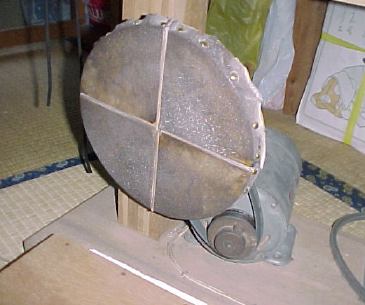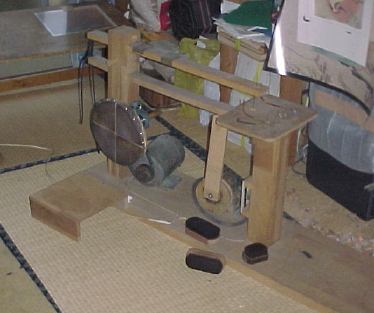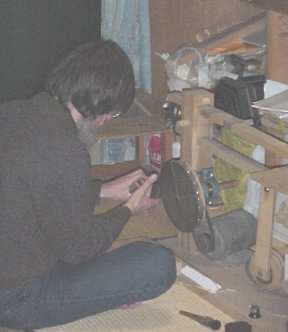Softening the Brushes by machine
The normal way for traditional Japanese printers to soften up their brushes (an essential and very important job), is to use a piece of sharkskin. The brush is moistened with hot water for a few minutes, and is then rubbed vigorously against the skin for anything up to 30 minutes, until the tips of the hairs have become finely shredded. Brushes treated this way will leave no 'streaks' in the colour on the block.
That procedure was very easy to describe, but the actual practice is quite a bit more difficult. The operative word is vigorously - gentle rubbing is completely useless, as is 'interrupted' rubbing. The brush must be rubbed against the skin continuously during the time; it seems that perhaps the heat that is generated is an important part of the process ...
120-pound weakling that I am, I have naturally looked around for an alternative to this procedure, a job that I find difficult and trying. I first considered using sandpaper for the job, and tried working some brushes against a disc sander that I have in my workshop. (The machine in this photo is actually my home-made jigsaw, but I added a disc sander to the back end of it some years ago. You can see where I have temporarily unhooked the jigsaw drive belt, to connect the disc unit ...)

Unfortunately, the experiment was a failure. The problem was that the tip of each hair, instead of being shredded into finer tips, simply became beveled off at an angle, kind of like the oval shape you get when you cut a piece of bamboo at an angle. The brushes are softened up quite a bit, but the sharp tips still leave streaks on the block. On to 'Plan B' ...

I had some extra pieces of sharkskin in my workshop (the two side 'fins' from a whole animal), so I cut four 'quarters', and glued them to the face of the wooden disc. (The four white lines you see are small strips of wood driven into slots to hold the edges of each segment firmly in place.) Each piece of skin is cut at an appropriate angle so that when the disc rotates, the cutting action is basically 'into' the teeth. As I glued the wet and soft pieces of skin into place (with white glue), I stretched them as I went, and then nailed them down around the edges like a drumskin.
Here's the 'converted' machine, ready for action. I've flipped the little work stand into the 'down' position, so that you can see the complete face of the disc.

Power on ... and away we go! It works like a charm, although I was quite surprised about the time it still takes to treat one brush. Given the good power available, I expected that a brush would be done in perhaps seconds, but it hasn't turned out that way. I have found that each brush must be treated against the disc for about five minutes for a 'touch up' job, and for nearly ten minutes for a new, untouched brush. But believe me ... I'm not complaining, because they come out soft ... soft ... soft!

So there she is - the world's first (?) 'Electric Sharkskin Brush Softener'! Patent Office, here I come! (not ...)
